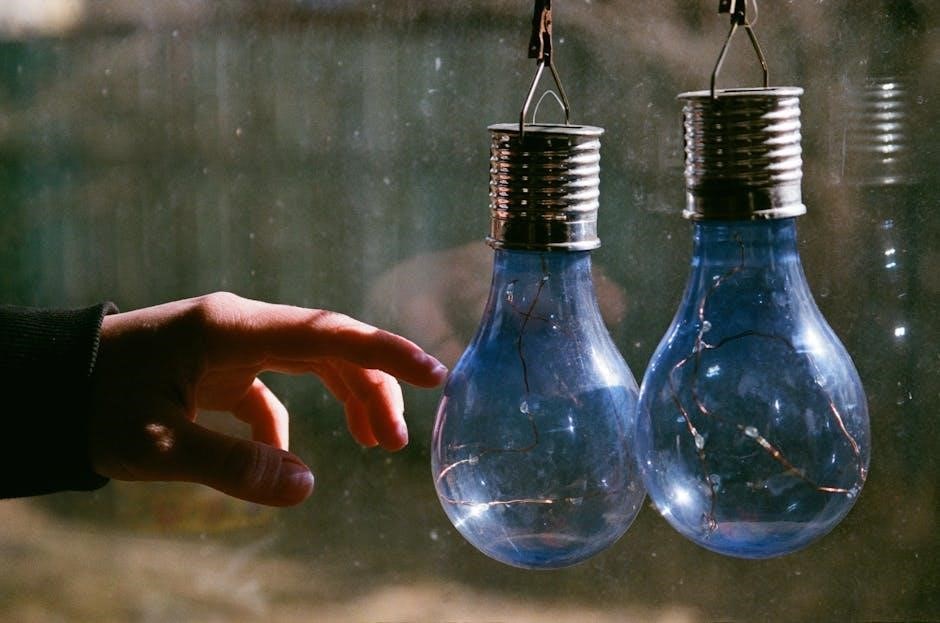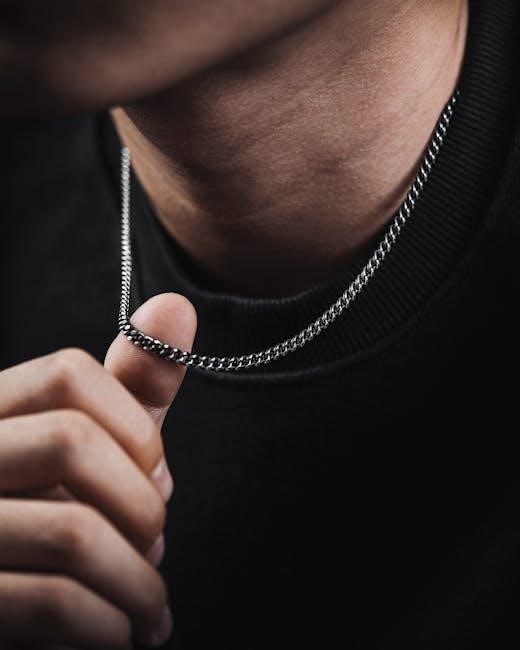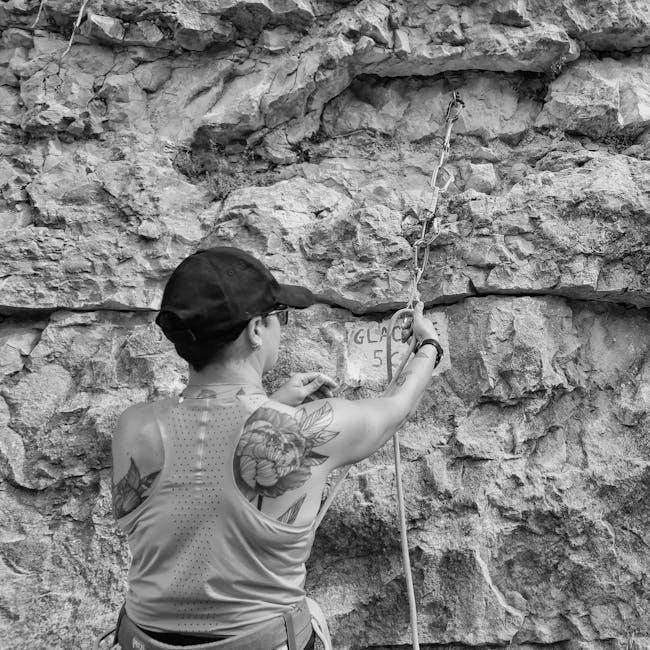The DRZ400 is a versatile dual-sport motorcycle known for its reliability and performance. Its engine features a cam chain system critical for valve timing. The “chain cam guide touching chain” issue refers to the cam chain guide making contact with the chain, potentially causing noise, wear, and performance loss. This guide explores the causes, symptoms, and solutions to this common problem, ensuring optimal engine function and longevity.
1.1 Overview of the DRZ400 Engine and Cam Chain System
The DRZ400 features a single-cylinder, four-stroke engine with a dual-overhead camshaft (DOHC) design. The cam chain system, including the chain and guides, is essential for synchronizing crankshaft and camshaft rotation, ensuring precise valve timing. The chain drives the camshaft, which operates the valves, while the guides maintain proper alignment and tension. This system is critical for engine performance, reliability, and overall power delivery. The DRZ400’s design balances durability and efficiency, making it a popular choice for both on-road and off-road enthusiasts. Proper maintenance of the cam chain system is vital to prevent issues.
1.2 Importance of the Cam Chain Guide
The cam chain guide is a critical component in the DRZ400 engine, ensuring the cam chain stays aligned and tensioned. It prevents the chain from derailing, which could cause catastrophic engine damage. By maintaining proper chain position, the guide optimizes valve timing and engine performance. Additionally, it reduces wear on the chain and other components, minimizing the risk of premature failure. A functioning guide is essential for smooth operation, reliability, and longevity of the engine, making it a key part of regular maintenance checks and inspections. Its role is indispensable for consistent power delivery and overall engine health.
1.3 Brief Explanation of the “Chain Cam Guide Touching Chain” Phenomenon
The “chain cam guide touching chain” issue occurs when the cam chain guide makes abnormal contact with the chain, leading to noise, wear, and potential performance loss. This phenomenon often results from misalignment, improper tension, or guide wear. It can cause rattling or slapping sounds, especially at lower RPMs, and may lead to visible wear on both the chain and guide. Addressing this issue promptly is crucial to prevent further damage to the engine’s timing system and ensure smooth operation. Regular inspection and maintenance are key to avoiding this problem.

Understanding the DRZ400 Cam Chain Guide
The DRZ400 cam chain guide is a durable component designed to maintain proper chain alignment, prevent derailment, and ensure smooth, consistent engine operation and reliability.
2.1 Design and Function of the Cam Chain Guide
The DRZ400 cam chain guide is engineered to maintain precise alignment and tension of the cam chain, ensuring smooth engine operation. Its design includes a durable material construction, often nylon or polymer, to reduce wear and noise. The guide is positioned strategically to prevent the chain from deviating from its path, which could lead to engine damage. Proper installation and alignment are crucial to its function, as misplacement can cause the guide to touch the chain, leading to premature wear and performance issues. Regular inspection is recommended to maintain optimal functionality.
2.2 Role of the Cam Chain Guide in Engine Performance
The cam chain guide plays a vital role in ensuring smooth engine performance by maintaining proper cam chain alignment and tension. It prevents the chain from derailing, which could disrupt valve timing and lead to engine damage. By guiding the chain accurately, it minimizes wear on both the chain and sprockets, ensuring consistent power delivery. Any malfunction in the guide can lead to noise, reduced performance, and potential engine failure, making it a critical component for reliability and optimal operation. Regular maintenance is essential to uphold its functionality.
2.3 Common Materials and Construction of the Guide
The DRZ400 cam chain guide is typically constructed from high-strength, wear-resistant materials such as durable plastics or metal alloys. These materials are chosen for their ability to withstand the constant friction and stress imposed by the moving cam chain. The guide’s design often features a smooth, slick surface to minimize friction and prevent chain wear. Its rigid structure ensures precise alignment, while lightweight materials help reduce overall engine weight. Proper construction is essential to maintain chain stability and prevent issues like misalignment or uneven wear.

Symptoms of a Cam Chain Guide Touching the Chain
Unusual noises like rattling or slapping sounds, increased vibration, reduced engine performance, and visible wear on the chain or guide are common indicators of this issue.
3.1 Unusual Noises (Rattling, Clicking, or Slapping Sounds)
Unusual noises are a primary indicator of the cam chain guide touching the chain. Rattling or clicking sounds often occur at lower RPMs, while slapping noises may be heard during acceleration. These sounds result from the chain impacting the guide, typically due to misalignment or wear. If left unaddressed, this can lead to further damage, emphasizing the need for prompt inspection and repair to maintain engine integrity and performance. Regular monitoring of these sounds is crucial for early detection and prevention of more severe issues.
3.2 Increased Vibration During Operation
Increased vibration during operation is another symptom of the cam chain guide touching the chain. Riders may feel this vibration through the handlebars or chassis, particularly during acceleration or at specific RPM ranges. This occurs as the chain and guide interact abnormally, disrupting the engine’s smooth operation. Such vibrations can lead to rider discomfort and may indicate underlying issues like misalignment or excessive tension. Addressing this early is crucial to prevent further damage and maintain a smooth ride. Regular inspection and adjustment can help mitigate this issue effectively.
3.3 Reduced Engine Performance and Power Output
When the cam chain guide touches the chain, it can disrupt the engine’s timing and efficiency, leading to reduced performance and power output. The chain’s irregular movement causes friction and resistance, which hinders smooth power delivery. Riders may notice a lack of responsiveness or a drop in acceleration. Over time, this issue can strain the engine, further diminishing its capacity to generate power. Addressing the problem early is essential to restore optimal performance and prevent long-term damage to the engine. Regular maintenance and inspections are key to maintaining peak functionality.
3.4 Visible Wear on the Chain or Guide
Visible wear on the chain or guide is a clear indicator of the “chain cam guide touching chain” issue. The repeated contact causes friction, leading to noticeable wear patterns, such as grooves or scratches on the guide. The chain may also show signs of excessive stretching or metal shavings. If left unaddressed, this wear can escalate, causing premature component failure. Regular inspections are crucial to identify these signs early and prevent further damage to the engine. Addressing wear promptly ensures the longevity and reliability of the DRZ400’s cam chain system.

Causes of the Cam Chain Guide Touching the Chain
The primary causes include incorrect cam chain tension, misalignment, wear and tear, and improper installation. These factors lead to the guide making contact with the chain.
Incorrect cam chain tension is a leading cause of the guide touching the chain. Over-tightening causes the chain to press against the guide, leading to wear and noise. Conversely, under-tension allows the chain to move excessively, potentially contacting the guide. Proper tension ensures smooth operation, preventing these issues. Misalignment of the cam chain or guide can cause the chain to rub against the guide, leading to noise and wear. This often occurs due to improper installation or wear over time. When the chain is not properly aligned with the sprockets, it can shift position, causing it to make contact with the guide. This misalignment can result in unusual noises and increased wear on both the chain and guide. Addressing misalignment promptly is crucial to prevent further damage and maintain smooth engine operation. Regular inspection and adjustment are key to avoiding this issue. Wear and tear on the cam chain or guide is a common cause of the guide touching the chain. Over time, the chain can stretch or the guide can wear down, leading to improper alignment. A worn chain may not sit correctly in the guide, causing it to rub against the edges. Similarly, a worn guide can no longer hold the chain in place, resulting in contact. This wear can be exacerbated by high mileage, lack of lubrication, or excessive tension. Regular maintenance is essential to prevent such issues from arising. Improper installation of the cam chain guide can lead to misalignment, causing the chain to touch the guide. This contact results in unusual noises and wear. If the guide isn’t securely fastened, it may vibrate or shift during operation, exacerbating the issue. Proper installation ensures the chain runs smoothly without touching the guide, preventing damage and maintaining engine performance. Any installation mistakes should be corrected promptly to avoid further complications. Troubleshooting involves inspecting the cam chain guide for wear, checking chain alignment, and ensuring proper tension. Listening for unusual noises and visually inspecting for chain contact can help identify issues early. Inspecting the cam chain guide involves checking for visible wear, cracks, or scoring on its surface. Use a flashlight and mirror to examine hard-to-reach areas. Look for misalignment signs, such as uneven wear patterns. If the guide shows significant damage or excessive play, replacement is necessary. Additionally, ensure the chain is clean and free from debris, as dirt can exacerbate wear. Proper inspection tools, like calipers or feeler gauges, can help assess guide clearance and chain tension accurately. Early detection of wear prevents costly repairs and maintains engine performance. Checking cam chain tension and alignment is crucial for preventing the guide from touching the chain. Use a feeler gauge to measure chain slack, ensuring it matches manufacturer specifications. Inspect the chain’s movement on both the top and bottom runs to confirm proper alignment. Misalignment or excessive tension can cause the chain to rub against the guide, leading to wear; If the chain is misaligned, adjust the guide or tensioner accordingly. Proper alignment ensures smooth operation and prevents premature wear on both the chain and guide, maintaining engine reliability. Misinstallation or manufacturing defects can cause the cam chain guide to touch the chain. Inspect for improper alignment or incorrect fitment of the guide. Check for visible damage, warping, or uneven surfaces on the guide or chain. Use a feeler gauge to measure chain-to-guide clearance, ensuring it matches specifications. Consult the service manual for proper installation procedures and torque values. If defects are found, replace the faulty component to restore proper function and prevent further damage. Address the issue by adjusting the cam chain tension, replacing a worn guide, or aligning the chain properly. Ensure correct installation and inspect for damage. Adjusting the cam chain tension is a critical step in resolving the “chain cam guide touching chain” issue. Start by loosening the tensioner and manually checking the chain’s slack. Ensure the chain is not overly tight or loose, as improper tension can exacerbate guide contact. Use a torque wrench to secure the tensioner bolt to the recommended specification. Proper alignment of the chain and guide should follow. This adjustment prevents excessive wear and noise, ensuring smooth engine operation. Always consult the service manual for precise torque values and procedures. Replacing the worn or damaged cam chain guide is essential to prevent further engine damage. Begin by removing the guide and inspecting for wear or misalignment. Install a new guide, ensuring it is securely fastened and properly aligned with the cam chain. This step eliminates contact between the chain and guide, reducing noise and wear. Always use OEM or high-quality aftermarket parts for reliability. Consult the service manual for specific torque specifications and installation procedures to ensure a precise fit and optimal performance. Proper alignment of the cam chain is critical to prevent it from touching the guide. Ensure the chain is correctly seated on the sprockets and not misaligned. Check the chain’s position relative to the guide and adjust as needed to eliminate contact. Use the correct tools to align the chain, ensuring it runs straight and true. Proper alignment reduces wear, noise, and the risk of engine damage. Refer to the service manual for specific alignment procedures and torque specifications to achieve optimal results. Reinstalling the cam chain guide requires precision to ensure proper fitment and function. Begin by aligning the guide with its mounting points, ensuring it is seated correctly without forcing it into place. Use the appropriate tools to secure the guide, following the manufacturer’s torque specifications. Double-check the guide’s alignment with the chain and sprockets to prevent misalignment. Proper installation prevents noise, wear, and potential engine damage. If unsure, consult the service manual or seek professional assistance for accurate guidance. Correct installation is key to maintaining optimal engine performance. Regular inspections of the cam chain and guide, along with proper lubrication and tension adjustments, are essential to prevent the cam chain guide from touching the chain. Regular inspection of the cam chain and guide is crucial for maintaining the DRZ400’s engine health. Check for signs of wear, misalignment, or damage on both components. Ensure the chain is properly lubricated and tensioned, as excessive tension can lead to premature wear. Inspect the guide for any debris or corrosion that might affect its function. Pay attention to unusual noises or vibrations, which could indicate issues. Regular checks help prevent the cam chain guide from touching the chain, ensuring smooth engine performance and longevity. Always follow the manufacturer’s maintenance schedule for best results. Regular lubrication and cleaning of the cam chain are essential for maintaining its performance and longevity. Use a high-quality motorcycle chain lube to ensure proper lubrication, which prevents wear and keeps the chain running smoothly. Clean the chain regularly to remove dirt and debris that can cause friction and wear. A wire brush can be used to gently scrub away grime, followed by wiping with a clean cloth. Proper lubrication and cleaning help prevent the cam chain guide from touching the chain, reducing noise and wear. Regular maintenance ensures optimal engine performance and reliability. Proper cam chain tension is critical to prevent wear and noise. Excessive tension can cause the guide to touch the chain, leading to premature wear and potential failure. Adjust the tension by loosening the axle and aligning the wheel, then tightening the bolts to maintain the correct tightness. Use a torque wrench to ensure bolts are properly secured. Regularly check tension to avoid engine damage. Improper tension can result in rattling sounds and reduced performance. Always refer to the manufacturer’s specifications for accurate adjustment. Proper tension ensures smooth operation and prolongs the life of the cam chain system. A rider experienced chain guide contact after improper tension adjustment. Inspection revealed misalignment, resolved by realigning the guide and adjusting tension, restoring smooth operation. A rider noticed a rattling noise from their DRZ400’s engine, diagnosed as the cam chain guide touching the chain. Upon inspection, the guide was misaligned due to improper tension. By adjusting the cam chain tension and realigning the guide, the noise was eliminated, restoring smooth operation. This case highlights the importance of regular inspections and proper adjustments to prevent engine damage. The repair was completed with basic tools, demonstrating how straightforward solutions can resolve common issues effectively. This example underscores the value of proactive maintenance. One common mistake when addressing the cam chain guide issue is neglecting to check the chain tension properly, leading to further misalignment. Another error is ignoring early symptoms like unusual noises, which can escalate into costly repairs. Additionally, improper installation of the guide, such as not aligning it correctly, can cause repeated problems. These experiences emphasize the importance of thorough inspection and following precise adjustment procedures; Learning from these mistakes helps riders maintain their DRZ400’s performance and prevent future issues. Regular maintenance and attention to detail are crucial. Proper maintenance, regular inspections, and addressing early symptoms are crucial to preventing cam chain guide issues. Regular chain tension checks and alignment adjustments help ensure smooth engine operation and prevent damage. By understanding the causes of guide-chain contact, riders can take proactive steps to maintain their DRZ400’s performance and longevity, avoiding costly repairs and ensuring reliable functionality. The cam chain guide is essential for maintaining the DRZ400’s engine performance and longevity. It ensures the cam chain remains aligned, preventing derailment and damage to critical components. Proper guide function minimizes wear, reduces noise, and maintains precise valve timing. Neglecting the guide can lead to costly repairs and potential engine failure. Regular inspections and maintenance are vital to uphold its role in the engine’s operation, ensuring smooth power delivery and reliability for both on-road and off-road adventures. The DRZ400 is a versatile dual-sport motorcycle known for its reliability and performance. Its engine features a cam chain system critical for valve timing. The “chain cam guide touching chain” issue refers to the cam chain guide making contact with the chain, potentially causing noise, wear, and performance loss. This guide explores the causes, symptoms, and solutions to this common problem, ensuring optimal engine function and longevity. For further assistance, consult OEM Suzuki guides, chain slider kits, and part-specific manuals. Visit official Suzuki resources or forums for detailed repair and maintenance support. To address the DRZ400 cam chain guide touching chain issue, essential tools include a service manual, cam chain tensioner tool, and chain tension gauge. Recommended parts are OEM Suzuki cam chain guides, replacement cam chains, and chain slider kits. Additionally, chain lube spray and specialized wrenches are beneficial. Consulting a professional mechanic with Suzuki expertise is advisable for complex repairs. Ensure all components are compatible with your DRZ400 model for optimal performance and durability. For comprehensive understanding, refer to the official Suzuki DRZ400 service manual for detailed repair procedures. Additionally, online forums like DRZ400 Subreddit and specialized repair guides offer practical insights. Videos from experienced mechanics provide step-by-step solutions. These resources cover troubleshooting, replacement of the cam chain guide, and maintenance tips to prevent future issues. They are invaluable for both novice riders and experienced mechanics aiming to resolve the cam chain guide touching chain problem effectively and ensure engine longevity.4.1 Incorrect Cam Chain Tension
4.2 Misalignment of the Cam Chain or Guide
4.3 Wear and Tear on the Cam Chain or Guide
4.4 Improper Installation of the Cam Chain Guide

Troubleshooting the Issue
5.1 Inspecting the Cam Chain Guide for Damage or Wear
5.2 Checking Cam Chain Tension and Alignment
5.3 Identifying Misinstallation or Manufacturing Defects

Solutions and Repairs
6.1 Adjusting the Cam Chain Tension
6.2 Replacing the Worn or Damaged Cam Chain Guide
6.3 Aligning the Cam Chain Properly
6.4 Reinstalling the Cam Chain Guide Correctly

Preventative Maintenance
7.1 Regular Inspection of the Cam Chain and Guide
7.2 Lubrication and Cleaning of the Cam Chain
7.3 Ensuring Proper Cam Chain Tension

Case Studies and Real-World Examples
8.1 Example of a Successful Repair
8.2 Lessons Learned from Common Mistakes

9.1 Recap of the Importance of the Cam Chain Guide
9.2 Best Practices for Maintaining the Cam Chain System

Additional Resources and Further Reading
10.1 Recommended Tools and Parts for Repair
10.2 Suggested Manuals and Guides for Further Reference
